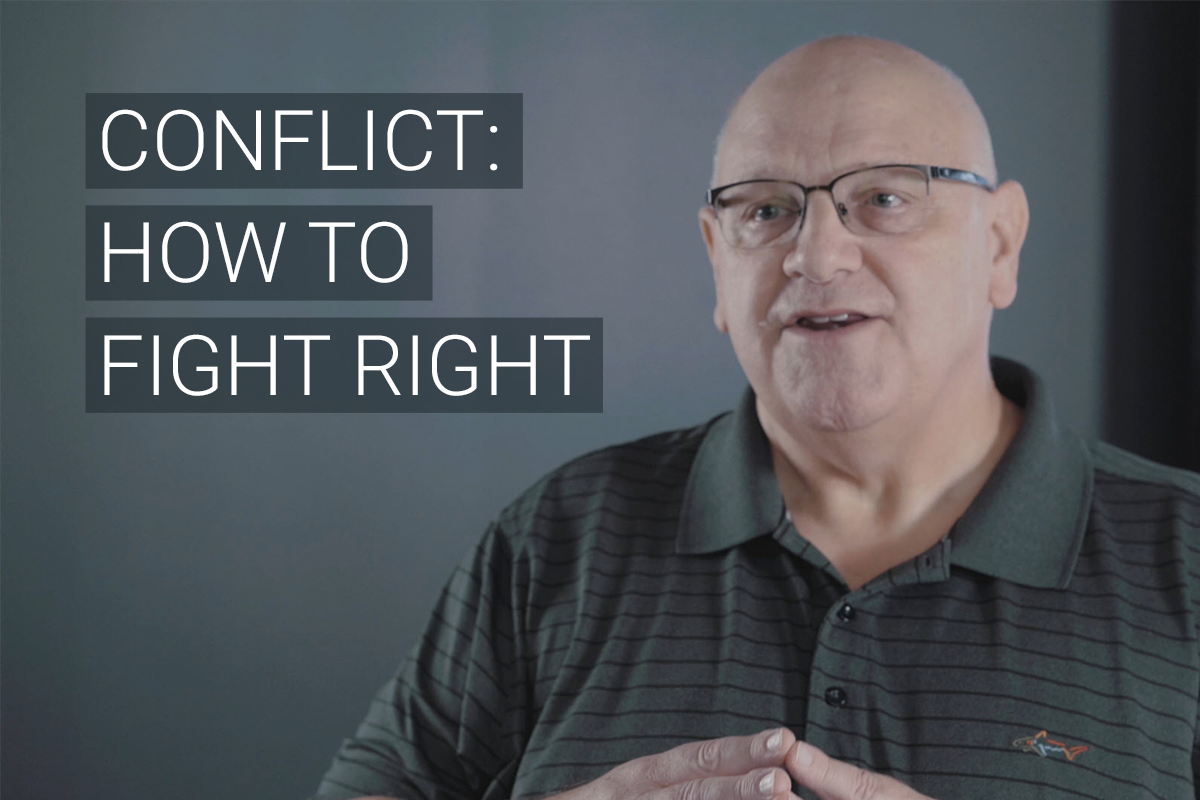If you have ever been on the front range of the Rocky Mountains between October and January, no doubt you have heard the clashing of the bighorn sheep as they battle it out for mating rights. Not only is this battling in conflict inevitable, it can and must happen not only in the animal kingdom but also in organizations.
While it is essential and inevitable (you won't be able to help that when you're putting humans together), you have the option to make it valuable by learning to fight right instead of letting it become toxic. Here are four elements in learning how to fight right and how to use conflict for productive rather than destructive means in your organization.
1. Respond. Don’t React.
The first thing to learn when dealing with conflict is how to respond and not react. If somebody criticizes you openly or makes an observation about something you did wrong or could have done better, simply say, “Thank you, that's helpful.” Don't go back at that person. That only causes escalation. When you react, you are saying, “You're wrong.” But when you respond, you are saying, “Thank you. That will help me to be an improved person as part of this team.”
If the following chart represents a boxing ring for conflict, you always want to go to the resolve corner, and that means there must be compromise. If you have to win, or if you have to yield in order to make peace, that is not resolution and is probably not going to benefit you.
2. Solve the Right Problem
A second tactic when dealing with conflict is to make sure that you are solving the right problem. It is amazing how many times a problem evolves into something that is not at the core issue of the conflict. Think of conflict as a mountain. At the bottom are the easiest things to reach, like goals and expectations. Those can be adjusted as long as they are what you are actually talking about. But the further you go up the mountain, the more personal the conflict becomes going from philosophy or theory to values and motivations, as if you can read someone’s mind. So, don't let the problem go to the top. Keep it at the bottom, and resolve the real problem at the time that it occurs. Don't let rhetoric force you up the mountain.
3. Get Perspective
The third element is to get perspective. To do so, walk yourself through this activity of imagining a baseball diamond.
On first base, you are trying to understand your own perspective. Articulate why you believe what you believe, what you think is most essential, and speak only for yourself.
On second base, you are trying to understand the other person’s perspective. This is where a person with higher emotional intelligence will be able to rightly articulate another person's point of view.
On third base, actually ask yourself, “If a jury heard my point of view and their point of view, who would they likely side with?” It forces you to think objectively.
At home base, think of your stakeholders. Would they be proud of the way you handled the conflict? Would they be proud of the outcome you helped bring about by the methodology of getting perspective?
4. Decide
The final tactic in dealing with conflict is to decide. Ultimately, conflict cannot be productive or healthy unless you come to a decision. When deciding, you have four options.
Agree: The decision could be, “We are going to agree. We have come to a common solution, and it has solved the conflict.”
Acquiesce: Another option might be to acquiesce. You say, “It's not what I prefer, but for the sake of moving forward and keeping the project/team unity/performance going in the right direction, I will acquiesce.” You have to pick your battles. Sometimes you stick it out, and sometimes you just let it go.
Accelerate: A third option is to accelerate the problem. Some people start fueling the conflict. They build unhealthy alliances, recruiting people to be on their side. And just like accelerating a fire with gasoline, they are actually engulfing the conflict with more fuel.
Stay Miserable: Lastly, some choose to just stay miserable. This is not a good option, but a lot of people do it, and they don't enjoy their work. They trudge through day by day, living with smoldering anger or unhappiness. You can choose this, but we don't recommend it.
These are the four tactics needed to fight right when you are in conflict. Comment below with your best tips for dealing with conflict in your organization!
Contact us for more information on how our coaches can help your team be more effective.
For more information on managing conflict, check our our video Conflict: Stop Reacting and Start Responding.
Dave Marks is a Senior Consultant at The Center Consulting Group and has over 35 years of church ministry experience including 23 years as a senior pastor. His consulting experience includes ministry assessment, leadership coaching, and strategic planning. Dave’s degrees include a B.S. in Bible, an M.S. in Organizational Leadership and a D.Min. in Leadership.





![Public Speaking: Using AI Ethically & Effectively to Create a Powerful Speech [VIDEO]](https://images.squarespace-cdn.com/content/v1/571fc0ea1d07c0fd6d72c167/1763735597032-XMIKMQ1D63PRC1QJ6FVV/ai+speech+blog.png)
![Preparing for the (Expectedly) Unexpected [VIDEO]](https://images.squarespace-cdn.com/content/v1/571fc0ea1d07c0fd6d72c167/e4193bcf-29f7-46c2-be12-9116791d40cf/unexpected+blog.png)
![Fundraising: How to Raise Funds for Your Nonprofit [VIDEO]](https://images.squarespace-cdn.com/content/v1/571fc0ea1d07c0fd6d72c167/1757619882819-6OARWR0QU11M7LA0ABYL/fundraising+blog.png)
![Culture: 5 Traits That Set Healthy Churches & Their Leaders Apart [VIDEO]](https://images.squarespace-cdn.com/content/v1/571fc0ea1d07c0fd6d72c167/1755633039402-KVJFNJWG0RKBCMLS5FNB/healthy+blog.png)
![Vision: 3 Must-Have Traits of Every Successful Visionary Leader [VIDEO]](https://images.squarespace-cdn.com/content/v1/571fc0ea1d07c0fd6d72c167/1749484247758-ITEGD2LZZ716112KLHXZ/visionary+blog.png)
![Advisory Boards: Should Your Business Have an Advisory Board? [VIDEO]](https://images.squarespace-cdn.com/content/v1/571fc0ea1d07c0fd6d72c167/1747149791510-HU20SY0O8LRPEHGMC6HD/advisory+blog.png)
![Leadership: How to Be a World Class Boss [VIDEO]](https://images.squarespace-cdn.com/content/v1/571fc0ea1d07c0fd6d72c167/1744640489138-X5LUNZT3JTRQYSSZXV1C/boss+thumbnail.png)
![Conflict: The Importance of Having Tough Conversations [VIDEO]](https://images.squarespace-cdn.com/content/v1/571fc0ea1d07c0fd6d72c167/1741365599296-KTWEJ5PTNH1BX2GJ9REJ/Conversations+blog.png)
![Exit Planning: The Challenge of Business Exit Planning & Why It Matters to You [VIDEO]](https://images.squarespace-cdn.com/content/v1/571fc0ea1d07c0fd6d72c167/1738339040891-VIW87N2NCZUCKLYNOHB6/exit+blog.png)

![Teams: Is Your Team Dysfunctional? [VIDEO]](https://images.squarespace-cdn.com/content/v1/571fc0ea1d07c0fd6d72c167/1733243870005-NOI69Z74DLNVLIB8MRRJ/dysfunctional+blog.png)
![How to Recruit and Inspire Volunteers [VIDEO]](https://images.squarespace-cdn.com/content/v1/571fc0ea1d07c0fd6d72c167/1728421227208-6JAUFVXEJW5KK6YE58JR/volunteers+blog.png)
![Trust: 4 Steps to Rebuild Damaged Trust [VIDEO]](https://images.squarespace-cdn.com/content/v1/571fc0ea1d07c0fd6d72c167/1725969594417-7AN9PJO2X8TTR77ACDFP/trust+blog.png)
![Blind Spots: How to Identify & Avoid Blind Spots in Your Organization [VIDEO]](https://images.squarespace-cdn.com/content/v1/571fc0ea1d07c0fd6d72c167/1722610352594-FAXECLPC61QYJH2I5YT8/blind+spot+blog.png)
![Family Business: Will the Family Business Destroy Our Family? [VIDEO]](https://images.squarespace-cdn.com/content/v1/571fc0ea1d07c0fd6d72c167/1718027719043-MU9AYPTQ7GM4XWT9EGD1/destroy+blog.png)
![Teams: How to Breathe New Life into a Broken Team [VIDEO]](https://images.squarespace-cdn.com/content/v1/571fc0ea1d07c0fd6d72c167/1714749389916-G2CWVK8OM1JJSD9058CL/breathe+blog.png)
![Planning: The Power of Planning [VIDEO]](https://images.squarespace-cdn.com/content/v1/571fc0ea1d07c0fd6d72c167/1712597764732-WHRZPRLZ6V78CBGKBPZA/PLanning+blog.png)
![Leveling Up Your Leadership: Becoming an Effective Senior Leader [VIDEO]](https://images.squarespace-cdn.com/content/v1/571fc0ea1d07c0fd6d72c167/1710266273593-QN3HEBJ5FII4GKQFH91Q/leveling+up+blog.png)
![Recruiting & Retaining “Mature” Team Members [VIDEO]](https://images.squarespace-cdn.com/content/v1/571fc0ea1d07c0fd6d72c167/1707849950823-Y5WJLYXM6ZPU55TKG27Y/recruitment+blog.png)

![Gaslighting: How to Identify It & Take Back Control [VIDEO]](https://images.squarespace-cdn.com/content/v1/571fc0ea1d07c0fd6d72c167/1699381799669-Y6XNYG2X3ZD1US80XAFY/Gaslighting+blog.png)
![Decision-Making: Why Smart Leaders Do Dumb Things [VIDEO]](https://images.squarespace-cdn.com/content/v1/571fc0ea1d07c0fd6d72c167/1696947285846-ZIA5M26B5AF9SRFGWFPV/Dumb+Things+blog.png)

![Meeting Effectiveness: 4 Different Types of Meetings & Why It Matters [VIDEO]](https://images.squarespace-cdn.com/content/v1/571fc0ea1d07c0fd6d72c167/1690296011536-23CWWE2VJ40QJ0UA1EZY/meetings+blog.png)
![Leadership: 4 Directions You Need to Lead [VIDEO]](https://images.squarespace-cdn.com/content/v1/571fc0ea1d07c0fd6d72c167/1689105063370-WQTIN47T3TP8YXQM3RMP/directions+blog.png)
![Leadership Model: Are You a Cheerleader, Drill Sergeant, or Coach? [VIDEO]](https://images.squarespace-cdn.com/content/v1/571fc0ea1d07c0fd6d72c167/1686670057921-DJ286QE8OZOQKE22SZAL/coach+blog.png)
![Developing Women Leaders: The Power of Leader Efficacy [VIDEO]](https://images.squarespace-cdn.com/content/v1/571fc0ea1d07c0fd6d72c167/1683572272369-EJ4N7BBXL0832YUM4XUN/Women+efficacy+blog.png)


![Innovation: How To Make Innovation Part of Your Leadership [VIDEO]](https://images.squarespace-cdn.com/content/v1/571fc0ea1d07c0fd6d72c167/1675365017628-0ZAPR2WCAM23JVDHM34I/Innovation+blog.png)